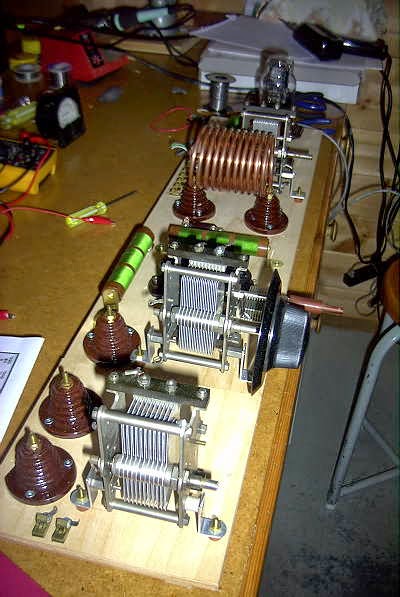 ’29 MOPA – Small Step
’29 MOPA – Small Step
 This morning I completed the wiring of the test-bed MOPA's Hartley oscillator circuit. I was using the 80m tank at the time, wound with 3/16" copper tubing. Oscillator keying is about what I expected ... stable but with some ripple on the note. Even with DC on the filaments, many of these open-breadboard oscillators suffer from RF-modulated notes. Sometime wrapping the power supply or keying leads in a ferrite toroid help or eliminate the slight rasp. On the other hand, some builders prefer to have a note that sounds more '29-like, as in all likelihood, not many notes sounded like pure DC back in the day.
This morning I completed the wiring of the test-bed MOPA's Hartley oscillator circuit. I was using the 80m tank at the time, wound with 3/16" copper tubing. Oscillator keying is about what I expected ... stable but with some ripple on the note. Even with DC on the filaments, many of these open-breadboard oscillators suffer from RF-modulated notes. Sometime wrapping the power supply or keying leads in a ferrite toroid help or eliminate the slight rasp. On the other hand, some builders prefer to have a note that sounds more '29-like, as in all likelihood, not many notes sounded like pure DC back in the day.I'm really having second thoughts about my construction method and may just jump to the next (final) construction phase rather than slog through completion of the test-bed model. I've already learned much about the layout by getting to this stage and the extra work involved in completing the test-bed model may not tell me anything new.
I'm using a VT-25 version of the somewhat pricey and hard-to-find type '10' tube. The final version will be built in a similar fashion to my Tri-Tet-Ten, on an aluminum sheet atop the breadboard. Hopefully having the groundplane and shorter leads, will lead to a cleaner note in the final version.
I'm rather dreading this next final phase as there is little room for error. The aluminum sheet must be precisely pre-drilled, as well as the breadboard, and protected at all times (especially when making soldered connections) to prevent any finger marks or scratching on the aluminum sheet. There are still several drilling details to be worked out before I can move forward.













